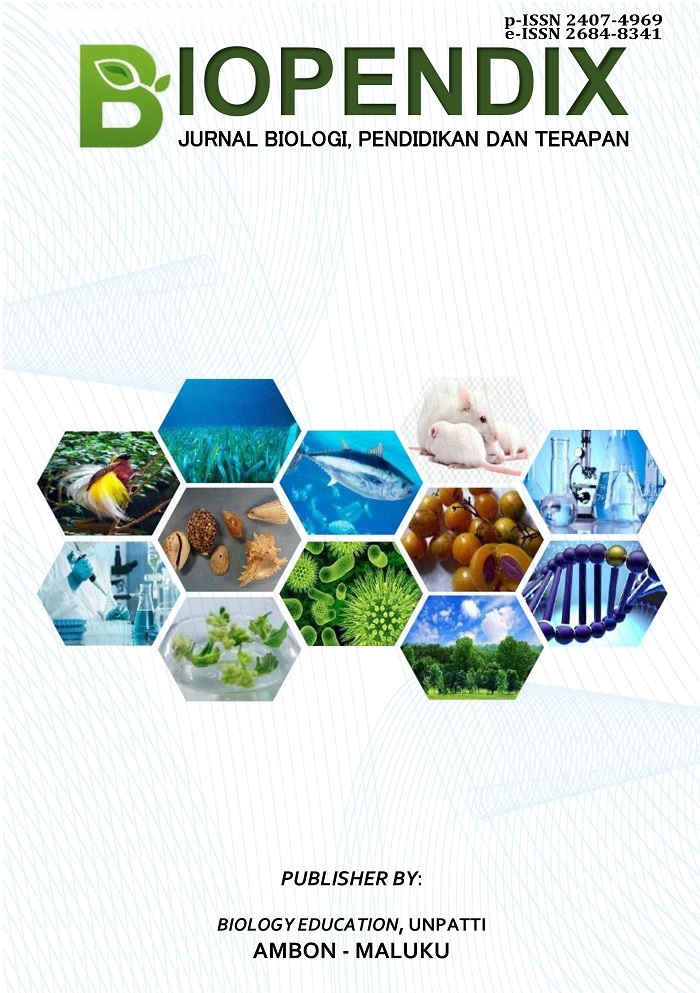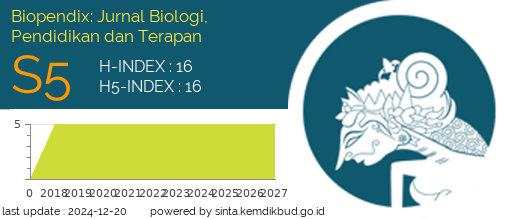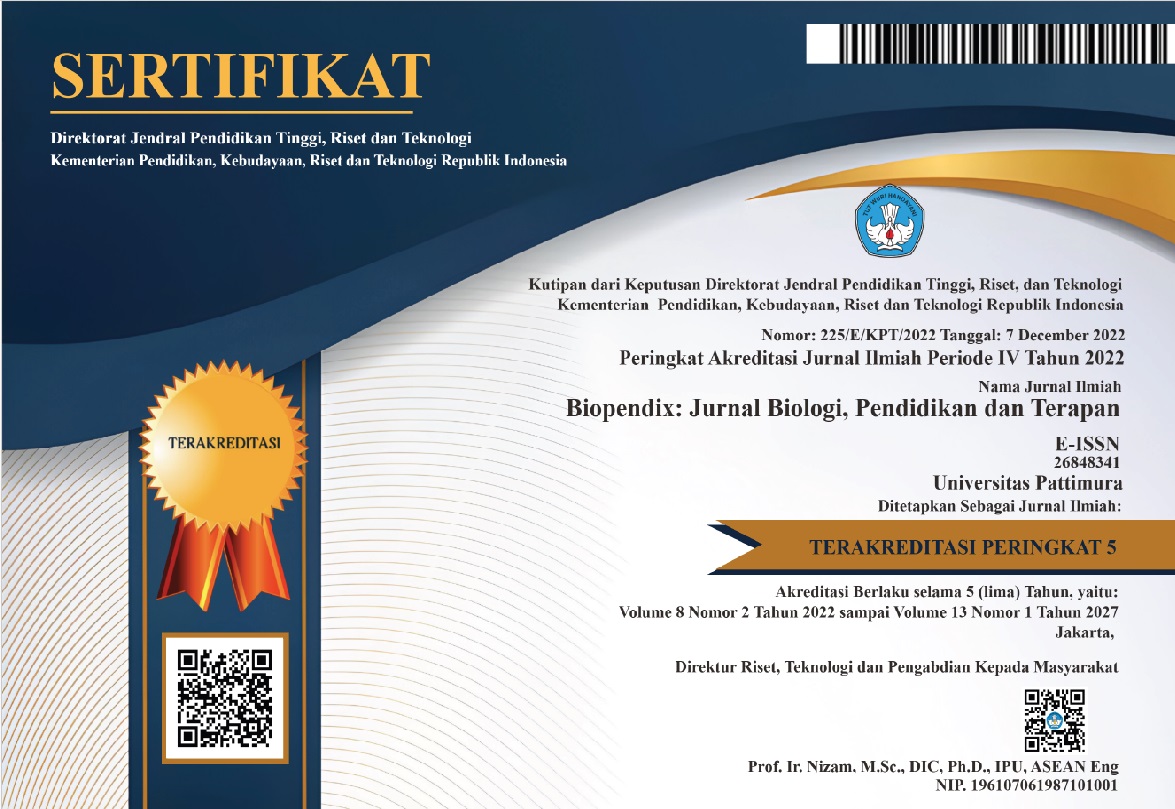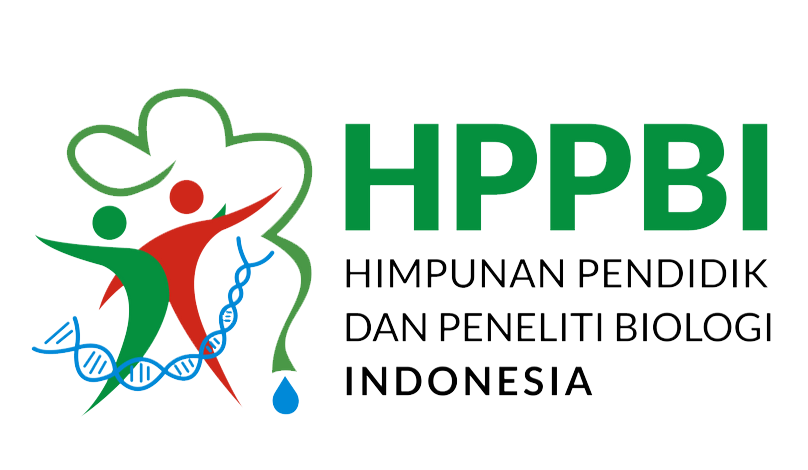Effectiveness of Tea Twig Liquid Smoke (Camellia sinensis) as an Antiseptic against Microbes in Vivo and In Vitro
Abstract
Transmission of microorganisms that cause disease in humans occurs directly or indirectly. Prevention efforts can use antiseptics. The content of liquid smoke compounds in tea twigs has the potential to be an antiseptic. The purpose of this study was to determine the effectiveness of liquid smoke from tea twigs (Camellia sinensis) on microbial growth in vitro using the inhibition test method and in vivo swab test on the palms. In the in vitro test, the most effective results were grade 2 liquid smoke with a concentration of 75% with an inhibition zone diameter of 18.1 mm (E. coli ATCC 25922), 15.6 mm (S. aureus ATCC 25923), 32.3 mm (A. flavus ATCC 9643), 4.3 mm (C. albicans ATCC 10231). The results of the in vivo test showed effectiveness in reducing the number of bacterial colonies by an average of 88.33%, and fungal colonies by an average of 91.52%. From the entire questionnaire data, the parameters of aroma, color, dryness are in the criteria of liking and do not cause side effects on the skin. The results of the study showed that liquid smoke from tea twigs has the potential as an antiseptic.
Downloads
References
Adhiningsih, Y. R., Athiyyah, A. F., & Juniastuti, J. (2019). Diare Akut pada Balita di Puskesmas Tanah Kali Kedinding Surabaya. Jurnal Ilmiah Kesehatan, 1(2), 96–101. https://doi.org/10.36590/jika.v1i2.31
Amelia, R., & Burhanuddin, N. (2018). Identifikasi Bakteri Staphylococcus aureus Dengan Infeksi Nosokomial Pada Sprei Di Ruang Perawatan Pascabedah Rsud Labuang Baji Kota Makassar. Jurnal Public Health, 1(9–10), 272–278.
Amila, A., Pardede, J. A., Simanjuntak, G. V., & Nadeak, Y. L. A. (2021). Peningkatan Pengetahuan Orang Tua Tentang Bahaya Merokok Dalam Rumah Dan Pencegahan Ispa Pada Balita. JUKESHUM: Jurnal Pengabdian Masyarakat, 1(2), 65–70. https://doi.org/10.51771/jukeshum.v1i2.119
Aristatia, N. (2021). Analisis Faktor - Faktor Yang Berhubungan Dengan Kejadian Infeksi Saluran Pernafasan Akut (Ispa) Pada Balita Di Puskesmas Panjang Kota Bandar Lampung Tahun 2021. Indonesian Journal of Helath and Medical, 1(4), 2774–5224.
Asngad, A., R, A. B., & Nopitasari, N. (2018). Kualitas Gel Pembersih Tangan (Handsanitizer) dari Ekstrak Batang Pisang dengan Penambahan Alkohol, Triklosan dan Gliserin yang Berbeda Dosisnya. Bioeksperimen: Jurnal Penelitian Biologi, 4(2), 61–70. https://doi.org/10.23917/bioeksperimen.v4i2.6888
Aznury, M., Hajar, I., Serlina, A., Kimia, J. T., Negeri, P., Srijaya, S., Bukit, N., & Palembang, B. (2021). Optimizing the Formula For Making Natural Antiseptic Soap With the Addition of Green Betel Leaf (Piper Betle L). Jurnal Kinetika, 12(01), 51–59. https://jurnal.polsri.ac.id/index.php/kimia/index51
D’Enfert, C., Kaune, A. K., Alaban, L. R., Chakraborty, S., Cole, N., Delavy, M., Kosmala, D., Marsaux, B., Fróis-Martins, R., Morelli, M., Rosati, D., Valentine, M., Xie, Z., Emritloll, Y., Warn, P. A., Bequet, F., Bougnoux, M. E., Bornes, S., Gresnigt, M. S., … Brown, A. J. P. (2021). The impact of the fungus-host-microbiota interplay upon Candida albicans infections: Current knowledge and new perspectives. In FEMS Microbiology Reviews (Vol. 45, Issue 3). https://doi.org/10.1093/femsre/fuaa060
Erlytasari, D. N., Wibisono, G., & Hapsari, R. (2019). Efektivitas Asap Cair Berbagai Konsentrasi Sebagai Disinfektan Alat Klinik Gigi. Jurnal Kedokteran Diponegoro, 8(4), 1114–1123. http://ejournal3.undip.ac.id/index.php/medico
Fitri, R., Agroteknologi, P. S., Pertanian, F., Peternakan, D. A. N., Islam, U., Sultan, N., & Kasim, S. (2024). Dalam Menghambat Pertumbuhan Ganoderma orbiforme ( Fr .) Ryvarden Secara in Vitro Dalam Menghambat Pertumbuhan Ganoderma orbiforme ( Fr .) Ryvarden Secara nn Vitro.
Hasanah, U. (2017). Mengenal Aspergillosis, Infeksi Jamur Genus Aspergillus. Jurnal Keluarga Sehat Sejahtera, 15(2), 76–86. https://doi.org/10.24114/jkss.v15i2.8777
Huliatunisa, Y., Alfath, M. D., & Hendiati, D. (2020). Cuci Tangan Bersih Menggunakan Sabun. Jurnal Pasca Dharma Pengabdian Masyarakat, 1(2), 40–46. https://doi.org/10.17509/jpdpm.v1i2.24027
Hung, Y. C., Hsiao, Y. H., & Hsieh, J. F. (2021). Catechin Content and Free Radical Scavenging Activity of Camellia sinensis Twig Extracts. International Food Research Journal, 28(2), 248–254. https://doi.org/10.47836/ifrj.28.2.03
Imas, A., Giyanto, G., Sinaga, M. S., Nawangsih, A. A., & Pari, G. (2018). Uji In Vitro Asap Cair terhadap Ralstonia syzygii subsp. celebesensis Penyebab Penyakit Darah pada Pisang. Jurnal Fitopatologi Indonesia, 14(4), 145. https://doi.org/10.14692/jfi.14.4.145
Indah Lestari, P. (2017). Aktivitas Antifungi Ekstrak Daun Teh Terhadap PertumbuhanAspergillus flavus. The Indonesian Journal of Infectious Diseases, 1(01), 29–38. https://doi.org/10.32667/ijid.v1i01.5
Kondo, S. A., Wibisono, G., & Ciptaningtyas, V. R. (2017). Konsentrasi Terhadap Pertumbuhan Streptococcus Sanguis Penyebab Gingivitis. Jurnal Kedokteran Diponegoro, 6(1), 6.
Mayasari, U. (2020). Uji Aktivitas Ekstrak Daun Pirdot (Saurauia vulcani Korth) Terhadap Pertumbuhan Bakteri Bacillus subtilis. KLOROFIL: Jurnal Ilmu Biologi Dan Terapan, 4(1), 1. https://doi.org/10.30821/kfl:jibt.v4i1.6488
Oramahi, H. A., Yoshimura, T., Diba, F., Setyawati, D., & Nurhaida. (2018). Antifungal and antitermitic activities of wood vinegar from oil palm trunk. Journal of Wood Science, 64(3), 311–317. https://doi.org/10.1007/s10086-018-1703-2
Pujilestari, T. (2015). Analisa Sifat Fisiko Kimia Dan Anti Bakteri Asap Cair Cangkang Kelapa Sawit Untuk Pengawet Pangan. Jurnal Riset Teknologi Industri, 4(8), 1. https://doi.org/10.26578/jrti.v4i8.1465
Sampepana, E., & Fauziati. (2021). Kajian Karakteristik Kimia Asap Cair Cangkang Sawit, Tandan Kosong Sawit sebagai Bahan Antibakteri dan Aplikasinya. Jurnal Riset Teknologi Industri, 15(2), 338–347.
Tea, E. O. G. (2018). Pengaruh pemberian seduhan teh hijau (Camellia sinensis) terhadap aktivitas superoksida dismutase (SOD). Jurnal Ilmiah Kedokteran Wijaya Kusuma, 2071(September), 158–164. https://www.academia.edu/download/71361130/pdf_1.pdf
Widaty, S. Budimulja, U. (2016). Dermatomikosis Superfisial. Ilmu Penyakit Kulit dan Kelamin. Edisi ke-7. Badan Penerbit FKUI. Jakarta
Yannuarista, D., Rintania, S., & Hilmi, M. (2020). Uji Organoleptik Dan Efektivitas Ekstrak Jeruk Nipis Sebagai Hand Sanitizer Alami. Seminar Nasional Terapan Riset Inovatif (SENTRINOV), 6(1), 1127–1134.
Copyright (c) 2025 Ayu Rahayu Nurul Ni'am, Aulia Nur Arrsy, Salsabila Zahroh, Feldha Fadhila, Nindya Sekar Mayuri, Alfi Rumidatul

This work is licensed under a Creative Commons Attribution-ShareAlike 4.0 International License.
Authors who publish with this Journal agree to the following terms:
- Author retain copyright and grant the journal right of first publication with the work simultaneously licensed under a creative commons attribution license that allow others to share the work within an acknowledgement of the work’s authorship and initial publication of this journal.
- Authors are able to enter into separate, additional contractual arrangement for the non-exclusive distribution of the journal’s published version of the work (e.g. acknowledgement of its initial publication in this journal).
- Authors are permitted and encouraged to post their work online (e.g. in institutional repositories or on their websites) prior to and during the submission process, as it can lead to productive exchanges, as well as earlier and greater citation of published works





 2
2






